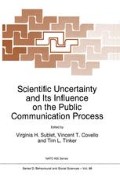Abstract
A major factor determining outcomes in environmental controversies is the trust and credibility of organizations involved in the debate. Given the importance of trust and credibility in environmental decision making, the purpose of this study is to examine the determinants of trust and credibility. Specifically, the study hypothesizes that trust and credibility are based on three factors: knowledge and expertise; openness and honesty; and concern and care. Using empirical data from a national survey, the study supports this hypothesis. The study also supports the hypothesis that an important method for improving perceptions of trust and credibility is to provide information that is contrary to negative stereotypes.
Access this chapter
Tax calculation will be finalised at checkout
Purchases are for personal use only
Preview
Unable to display preview. Download preview PDF.
References
Ruckelshaus, W.D. (1983) Science, risk, and public policy, Science 221, 1026–1028.
Lipset, S.M. and Schneider, W. (1983) The decline of confidence in American institutions, Political Science Quarterly 98, no. 3, 379–402.
National Civic Review. (1992) Opinion poll: Confidence in all levels of government is down, but local government still most trusted, 81, no. 4, 518–519.
Harris, L. and Associates. (1993) Confidence in leadership, Harris Poll No. 11 (March 1).
Laird, F.N. (1989) The decline of deference: The political context of risk communication, Risk Analysis 9, no. 2, 543–550.
Solmsen, F. (ed.) (1954) The Rhetoric and Poetics of Aristotle, the Rhetoric translated by W.R. Roberts, Random House, New York, NY.
Kasperson, R.E. (1986) Six propositions on public participation and their relevance for risk communication, Risk Analysis 6, no. 3, 275–281.
Kasperson, R.E., Golding, D., and Tuler, S. (1992) Social distrust as a factor in siting hazardous facilities and communicating risks, Journal of Social Issues 48, no. 4, 161–187.
Barber, B. (1983) The Logic and Limits of Trust, Rutgers University Press, New Brunswick, NJ.
Renn, O. and Levine, D. (1991) Credibility and trust in risk communication, in Kasperson and Stallen (eds.), Communicating Risks to the Public, Kluwer Academic Publishers, Dordrecht, The Netherlands.
Covello, V.T. (1992) Trust and credibility in risk communication, Health and Environment Digest 6, no. 1, 1–3.
Covello, V.T. (1993) Risk communication and occupational medicine, Journal of Occupational Medicine 35, no. 1, 18–19.
McCallum, D.B., Hammond, S.L., and Covello, V.T. (1991) Communicating about environmental risks: How the public uses and perceives information sources, Health Education Quarterly 18, no. 3, 349–361.
Douglas, M. and Wildaysky, A. (1982) Risk and Culture, University of California Press, Berkeley, CA.
Wildaysky, A. and Drake, K. (1990) Theories of risk perception: Who fears what and why? Daedalus 119, 41–60.
Slovic, P. (1986) Informing and educating the public about risk, Risk Analysis 6, no. 4, 403–415.
Slovic, P. (1987) Perception of risk, Science 236, 280–285.
Kasperson, R.E., Renn, O., Slovic, P., Brown, H.S., Emel, J., Goble, R., Kasperson, J.X., and Ratick, S. (1988) The social amplification of risk: A conceptual framework, Risk Analysis 8, no. 2, 177–187.
Covello, V.T. (1991) Risk comparisons and risk communication, in Kasperson and Stallen (eds.), Communicating Risks to the Public: International Perspectives, Kluwer Academic Publishers, Dordrecht, The Netherlands.
Tversky, A. and Kahneman, D. (1974) Judgement under uncertainty: Heuristics and biases, Science 185, 1124–1131.
Tversky, A. and Kahneman, D. (1975) Judgement under uncertainty: Heuristics and biases, in Wendtand Vlek (eds.), Utility, Probability and Human Decision Making, D. Reidel, Boston, MA.
Cialdini, R.B. (1987) Compliance principles of compliance professionals: Psychology of necessity, in Zanna, Olson, and Herman (eds.), Social Influence: The Ontario Symposium, Vol. 5, Lawrence Erlbaum Associates, Hillsdale, NJ.
Cialdini, R.B. (1988) Influence: Science and Practice, HarperCollins, New York.
Baumeister, R.F. (1982) A self-presentational view of social phenomena, Psychological Bulletin 91, no. 1, 3–26.
Miller, N., Maruyama, G., Beaber, R.J., and Valone, K. (1976) Speed of speech and persuasion, Journal of Personality and Social Psychology 34, no. 4, 615–624.
Taylor, S.E. (1981) The interface of cognitive and social psychology, in Harvey (ed.), Cognition, Social Behavior and the Environment, Erlbaum, Hillsdale, NJ.
Chaiken, S. (1987) The heuristic model of persuasion, in Zanna, Olson, and Herman (eds.), Social Influence: The Ontario Symposium, Vol. 5, Lawrence Erlbaum Associates, Hillsdale, NJ.
Festinger, L. (1957) A Theory of Cognitive Dissonance, Stanford University Press, Stanford, CA.
Likert, R. (1932) The method of constructing an attitude scale, Archives of Psychology 140, 44–53.
U.S. Environmental Protection Agency. (1990) Public Knowledge and Perceptions of Chemical Risks in Six Communities: Analysis ofa Baseline Survey, USGPO, Washington, DC.
Babbie, E. (1989) The Practice of Social Research, Wadsworth Publishing, Belmont, CA.
Klein, D.F. (1990) NIMH collaborative research on treatment of depression, Archives of General Psychiatry 47, 682–684.
Rothman, K.J. (1986) Modern Epidemiology, Little, Brown and Company, Boston, MA.
Fleiss, J.L. (1986) The Design and Analysis of Clinical Experiments, John Wiley and Sons, New York, NY.
Dawson-Saunders, B. and Trapp, R.G. (1990) Basic and Clinical Biostatistics, Prentice Hall, Englewood Cliffs, NJ.
SPSS/PC+ Statistics 3.1. (1988) SPSS, Inc., Chicago, IL.
U.S. Bureau of the Census. (1990) Statistical Abstract of the United States, USGPO, Washington, DC.
Kennedy, G.A. (trans.) (1991) Aristotle on Rhetoric: A Theory of Civic Discourse, Oxford University Press, New York, NY.
Keeble, J. (1991) Out of the Channel: The Exxon Valdez Oil Spill in Prince William Sound, HarperCollins, New York, NY.
Mayer, M. (1993) Making News, Harvard Business School Press, Boston, MA.
Leiss, W. (1994) Risk and Responsibility, McGill-Queen’s University Press, Montreal, Canada.
Author information
Authors and Affiliations
Editor information
Editors and Affiliations
Rights and permissions
Copyright information
© 1996 Springer Science+Business Media Dordrecht
About this chapter
Cite this chapter
Covello, V.T., Peters, R.G. (1996). The Determinants of Trust and Credibility in Environmental Risk Communication: An Empirical Study. In: Sublet, V.H., Covello, V.T., Tinker, T.L. (eds) Scientific Uncertainty and Its Influence on the Public Communication Process. NATO ASI Series, vol 86. Springer, Dordrecht. https://doi.org/10.1007/978-94-015-8619-1_3
Download citation
DOI: https://doi.org/10.1007/978-94-015-8619-1_3
Publisher Name: Springer, Dordrecht
Print ISBN: 978-90-481-4737-3
Online ISBN: 978-94-015-8619-1
eBook Packages: Springer Book Archive

